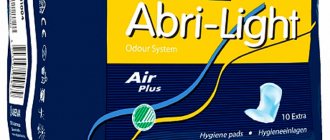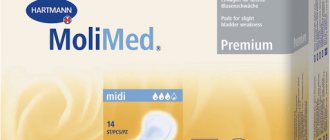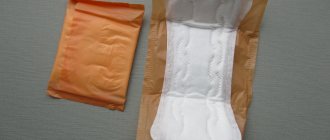*Review of the best according to the editors of expertology.ru. About the selection criteria. This material is subjective in nature, does not constitute advertising and does not serve as a purchase guide. Before purchasing, consultation with a specialist is required.
In the modern world, it is very difficult to give up goods that make our lives much easier. Women's pads are no exception. Their range is so wide that it can satisfy any need in different situations. There are postpartum, urological, and daily pads. And, of course, the most common type is sanitary napkins for menstrual flow. All of them differ not only in purpose and degree of absorption, but also in shape, as well as material of manufacture.
Our magazine's experts have compiled a rating of pads that are recognized by experts as the best products and have the most positive reviews from women.
Why do you need panty liners?
Daily routines are an excellent opportunity to monitor intimate hygiene. They are especially indispensable when the discharge is light or specific. It happens:
- before and after menstruation to protect against unexpected leakage or residual discharge;
- during menstruation, when using tampons (as additional insurance for underwear);
- for problems with urinary incontinence, which sometimes happens after childbirth and in other cases;
- when undergoing a course of treatment with suppositories;
- during ovulation, when intravaginal secretion increases.
But what are panty liners? This is a multi-layer system, where each layer performs a specific function:
- Superficial – in contact with the skin, made of porous material and must allow all secretions to pass through.
- Absorbent filler. These can be granules or absorbent fiber. Designed to retain secretions and neutralize odor.
- Impermeable film coated with adhesive for fixation to linen.
Manufacturers often offer panty liners with deodorizing properties and make them in different colors and shapes.
When can using such tools help?
Naturally, the wording “urological pads” involuntarily suggests the main purpose of this device. You may have undergone surgery on the reproductive or urinary organs, or the cause of the problem may be menopausal changes caused by estrogen deficiency.
In particular, the use of these hygienic structures during pregnancy has become very popular, when incontinence can be caused by the pressure of the enlarged uterus on the organs of the urinary system.
Urological pads can literally be a salvation in the postpartum period. Increased absorbency and an antibacterial layer prevent the development of pathogenic microflora and eliminate the endless change of hygiene products during periods of heavy bleeding (lochia). Therefore, it would be most reasonable to buy several packages of similar products when packing your bag for the maternity hospital.
When menstruation begins, it is not recommended to use the usual soap or washing gel. Especially for girls whose skin is predisposed to irritation and dryness. Simple products contain large quantities of alkalis. The skin already suffers from constant contact with pads; it should not be additionally loaded with aggressive substances.
It is recommended to select special gels for washing intimate areas. Their action is gentle, but at the same time effective. They help get rid of sweat and bacteria, but the effect is gentle. Instead of such a gel, you can take baby soap that does not contain fragrances, artificial colors, or substances that can irritate or dry out the epidermis and mucous membranes.
These are small, dense tubes with a cord at the end. Some are equipped with an applicator, which allows you to easily insert it into the vagina. They are more convenient than pads, are not visible even under thin clothing, and allow you to move more (which sometimes doesn’t happen with pads). Tampons also need to be purchased, taking into account the volume of discharge.
Based on these factors they are divided into:
- Mini. Suitable for young girls with a small amount of liquid.
- Normal. Used in medium moisture conditions.
- Super. The best option for heavy periods.
Changes occur at the same intervals as gaskets. When secretions are absorbed by a product that is constantly in contact with the mucous membrane, microbes are rapidly activated and begin to multiply. This is fraught with negative processes - inflammation or even infection.
What's better?
For constant use, it is better to use gaskets. They absorb more liquid and prevent stagnation. But sometimes tampons are a priority. It is advisable to use them in the following situations:
- When playing sports and active physical exercise.
- When visiting a swimming pool or outdoor swimming areas, if you need to go to the beach.
- During hot periods, to avoid skin irritation.
DETAILS: Diet (nutrition) or what you can eat after surgery to remove prostate adenoma: contraindications, tips and recommendations
Application in such situations also has its own rules - change before starting water procedures and at the end. This is a necessary measure, since bacteria can penetrate into the vagina through the traction rope, causing unpleasant processes, because the water is not sterile, not distilled, not boiled. There are no restrictions on pads; they are allowed to be used at any time and at any age, but there are certain restrictions on the use of tampons, including:
- The postpartum recovery period is at least three months.
- After gynecological operations.
- Inflammatory processes in the external or internal genital organs.
- Infectious processes in the organs of the reproductive system, including sexually transmitted diseases.
Maintaining hygiene during critical days is an important measure; it helps to survive this period with maximum comfort and cleanliness.
The materials from which gaskets are made can also vary. Some may have a cotton component inside. But such products are less and less in demand among women, since they are not always reliable. Others have a special sorbent that perfectly retains moisture and turns it into a gel.
Differences may be in the top layer. Typically this is either a synthetic porous material or fluff pulp. Like any material, each layer has its pros and cons. In the first case, the discharge is quickly absorbed without leaking, but after using such pads, irritation may occur. In the second case, they are not so practical, but they are advised to be used by women who have increased sensitivity of the genital mucosa.
The benefits of panty liners
High-quality hygiene products provide additional comfort at all times. They have a soft, skin-friendly top layer. With their help, you can protect intimate areas of the body from irritation and ensure comfortable wearing of underwear. Some manufacturers produce panty liners that follow the contours of the body and adapt to its movements.
Of course, such hygiene products have many advantages. In some cases, for example, during long trips, when it is not possible to change linen, they are irreplaceable.
The product has no contraindications as such. Studies have shown that daily wearing of disposable pads by healthy women did not affect their health.
Instructions
How to combine child care and caring for the planet
The baby products industry is a real horror story for eco-conscious parents. Everywhere there is an abundance of disposable, plastic and...
Anna Tyatte 05/01/2021
Demand a limit on single-use plastic in your region
In order for the work done on plastic watching to provide maximum benefit, we suggest you contact regional...
Antonina Evteshina 27/08/2020
How to organize a separate collection at the university?
All over Russia, students assemble teams, establish connections with university administrations, win grants - everything...
Tamara Kuzminova 19/08/2020
Materials and composition of panty liners
Many modern manufacturers strive for maximum safety of their products, as well as their reliability and ease of use. As a rule, “daily items” consist of several layers:
- surface - made of fiber material (polypropylene, polyethylene, polyester, viscose);
- distribution layer - porous material made of synthetic or wood fiber;
- absorbent layer - a combination of cellulose and superabsorbents is used in the manufacture of panty liners and sanitary pads;
- adhesive layer (polymers, synthetic resins);
- substrate. Typically, polyethylene film or fibrous material is used.
Individual panty liners are supplemented with fragrances. To emphasize the form and function of hygiene products, various prints can be applied to them using ink.
Types of panty liners
Differences between products may relate to a number of characteristics. Thus, products are classified by shape. Models that are straight or tapering towards the middle are considered standard. In addition, there are options for different panties: in the form of shorts, thongs, thongs, etc. Some products are complemented with wings. As for color, white products are the most common. But you can find colored or black panty liners.
“Daily days” are also divided according to the amount of secretions absorbed. Information about their capacity is contained on the packaging:
- For small amounts of discharge, you can use 1 or 2 drop models.
- 3-4 drop options are designed to hold large volumes of liquid.
The differences between products with different degrees of protection lie in thickness.
Many companies specializing in hygiene products are involved in the production of panty liners. Top Brands:
- Libresse. Daily Fresh Multi Style products have a universal shape;
- Discreet. Normal series products have gained popularity due to their high quality;
- Always. The brand's products for every day are distinguished by their very small thickness and anatomical shape;
- Carefree. Breathable models have a very soft top layer, etc.
Interesting publications
How to combine child care and caring for the planet
The baby products industry is a real horror story for eco-conscious parents. Everywhere there is an abundance of disposable, plastic and...
Anna Tyatte 05/01/2021
How to celebrate the New Year environmentally
Where is Greenpeace looking? · How to celebrate the New Year environmentally Listen to us on Yandex.Music, Apple podcasts, Google…
Andrey Allahverdov Irina Skipor Olesya Vikulova Violetta Ryabko Ksenia Sabinina 12/27/2020
What to wrap a gift in so as not to harm nature
During the holidays, stores are filled with shoppers and the environment is filled with holiday packaging. A minute after unpacking the gift...
Ksenia Sabinina 25/12/2020
Random New Year's Eco Resolution Generator
Even a tiny step towards conservation is important, and we invite you to choose one! Let be…
Irina Skipor 24/12/2020
Stores without packaging will live
Rospotrebnadzor has published new SanPiN regulating the sale of food products. They will come into force on January 1, 2021...
Ksenia Sabinina 24/12/2020
Differences between panty liners and regular pads
A regular sanitary pad is structurally similar to a daily pad. It consists of the same layers and performs similar functions, but they are still used for different purposes. Therefore, the shape, size and thickness of products change. It should be noted that conventional gaskets are made with a fairly wide adhesive base, since their capacity is designed for a large volume of liquid. Daily ones, on the contrary, are made as light as possible so that the woman does not notice them during the day. In addition, they cannot be used while sleeping, unlike regular ones, which are designed to be worn around the clock. They also produce special night pads for protection while lying down.
How to know when it's time to change your pad during your period
The normal duration of menstruation is 5-6 days. In one day of menstruation, a woman loses from 15 to 60 ml of blood, depending on the individual characteristics of the body. If menstruation lasts more than 7 days, and blood loss is more than 60 ml per day (more than 150 ml in general), they speak of menorrhagia - blood loss that exceeds the physiological norm. A reduction in the duration of critical days and the volume of blood loss is called oligomenorrhea.
The amount of blood loss also depends on the day of menstruation - at the beginning of menstruation, the discharge is spotting, reaching a maximum on the 2-3 day, after which its amount gradually decreases towards the last day. Accordingly, the daily consumption of pads also changes.
How often you need to change pads during menstruation will help you understand the absorbency limit of the product. If the surface of the pad is relatively dry, then its absorbency is still sufficient. If liquid begins to seep from its surface, you should change the gasket without waiting for a leak. Some doctors recommend changing the pad at certain experimentally determined intervals, every 3-6 hours. Of course, the frequency of changing pads is affected by their absorbency - more capacious products are usually less comfortable, which is why they are recommended to be used at night. Thin pads are more comfortable during the day, but they will have to be changed more often.









